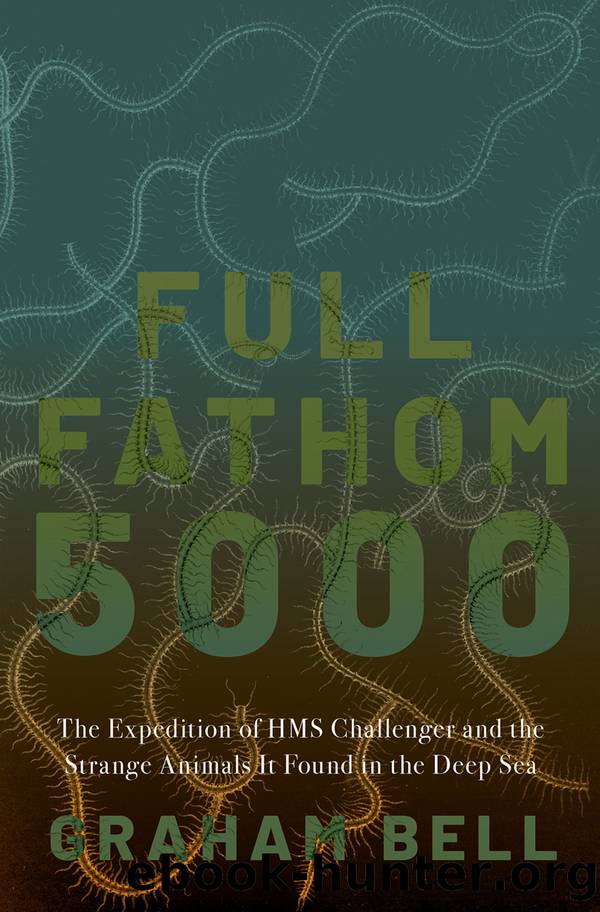Full Fathom 5000 by Bell Graham;

Author:Bell, Graham;
Language: eng
Format: epub
Publisher: Oxford University Press USA - OSO
Published: 2021-07-15T00:00:00+00:00
Station 166: 23 June 1874
38°50ⲠS, 169°20ⲠE; Challenger Plateau, 275 fathoms
Challenger was seen off by a large crowd and a musical serenade from the bands of the ships in the harbor when she left Sydney for New Zealand on 8 June, 25 men short of complement despite retrieving several deserters who had been jailed. The main purpose of the passage was again surveying, this time to take soundings along the line of a proposed telegraph cable linking Australia and New Zealand. Dredging would be attempted when possible, but natural history was secondary to the main business to find out whether the seabed was suitable for cable-laying; ideally it would be covered by a thick layer of ooze, and any hard bottom should at any rate be smooth (which would in fact best be shown by seeing whether the dredge snagged). During calm weather in shallow water it was quite straightforward to take a soundingâessentially, lowering a heavy weight on a rope until it reached the bottomâexcept that a sailing ship would inevitably move with wind or current as the lead descended, until the sounding line was far from vertical and the depth consequently uncertain. I have already mentioned how Challenger could take accurate soundings by using her engine to balance wind and current with the screw, holding the ship almost stationary in the water. In preparing to sound, then, steam was first got up, the sails furled, and the ship turned head to wind. The leadsman stood on one of the two sounding platforms that jutted from the side of the ship at the level of the foremast on the upper deck and lowered the weighted sounding line, which led from storage reels on deck through a pulley suspended from elastic âaccumulators,â directly into the sea. The sounding line itself was a hemp rope about as thick as a little finger, with a breaking strain of about 1,500 pounds or 700 kilograms, marked at 25-fathom intervals with a color-coded twist of worsted. The weights were up to eight 56-pound cast-iron cylinders, which detached automatically from the line when the bottom was reached. Their combined weight drove a hollow iron cylinder closed with a butterfly valve into the sediment, taking a sample that could be hauled back to the surface and preserved. Just over 500 samples were taken like this during the voyage, and although one jar of mud is much the same as the next to the untrained eye, they revealed, perhaps, just as much about the deep sea as the animals captured by dredge or trawl.
The weather, however, was anything but calm. Even on setting out it was so bad that Nares abandoned the attempt, since sounding was out of the question, and returned to anchor in Watsonâs Bay. The ship finally struggled clear of land on 12 June and set out east across the Tasman Sea. Within two days they were sounding in the deep water of the Tasman Abyssal Plain. This needed more sophisticated equipment than the simple deep-sea lead, but it was lost anyway when the line broke.
Download
This site does not store any files on its server. We only index and link to content provided by other sites. Please contact the content providers to delete copyright contents if any and email us, we'll remove relevant links or contents immediately.
The Lonely City by Olivia Laing(4750)
Animal Frequency by Melissa Alvarez(4395)
All Creatures Great and Small by James Herriot(4233)
Walking by Henry David Thoreau(3894)
Exit West by Mohsin Hamid(3778)
Origin Story: A Big History of Everything by David Christian(3649)
COSMOS by Carl Sagan(3554)
How to Read Water: Clues and Patterns from Puddles to the Sea (Natural Navigation) by Tristan Gooley(3409)
Hedgerow by John Wright(3276)
The Inner Life of Animals by Peter Wohlleben(3259)
How to Read Nature by Tristan Gooley(3249)
How to Do Nothing by Jenny Odell(3232)
Project Animal Farm: An Accidental Journey into the Secret World of Farming and the Truth About Our Food by Sonia Faruqi(3178)
Origin Story by David Christian(3148)
Water by Ian Miller(3128)
A Forest Journey by John Perlin(3027)
The Plant Messiah by Carlos Magdalena(2883)
A Wilder Time by William E. Glassley(2818)
Forests: A Very Short Introduction by Jaboury Ghazoul(2790)
